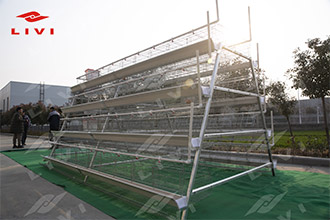Are you looking for reliable and efficient chicken farming equipment for your poultry business?
Why Choose A-type 4-Tier Layer Battery Cages? If you're serious about maximizing your space and resources in poultry farming, then A-type 4-tier layer battery cages are the perfect choice. These cages are designed to provide optimal space efficiency, ease of management, improved health and productivity of chickens, and long-term durability. They are ideal for urban or semi-urban farming environments where space is limited.

Features of A-type 4-Tier Layer Battery Cages LIVI Poultry Equipment Factory's A-type 4-tier layer battery cages are made from high-quality materials, ensuring they are durable and built to last. The vertical design of the cages allows farmers to keep a high number of layers in a limited space. They are also equipped with automated feeding systems, advanced watering systems, waste management systems, and proper ventilation and lighting systems to create an optimal living condition for the layers.
Customer Testimonials and Success Stories Our A-type 4-tier layer battery cages have received positive feedback from farmers across different regions. John Mwangi from Kenya says his egg production has doubled since switching to our cages. Amina Adewale from Nigeria highly recommends our cages for their durability and efficiency. Peter Otieno from Kenya says the investment in our chicken cages has paid off tremendously.
How to Purchase and Install A-type 4-Tier Layer Battery Cages Purchasing and installing our A-type 4-tier layer battery cages is a straightforward process. Contact us through our website or customer service hotline to discuss your requirements and get a quote. Once you have decided on the specifications and quantity, place your order. We offer competitive pricing and various payment options to suit your needs. We ensure timely delivery of the cages to your location in Ibadan or any other part of Nigeria. Our team of experts is available to assist with the installation process. We also provide comprehensive after-sales support, including maintenance tips and troubleshooting assistance to ensure your farming operations run smoothly.
Conclusion Investing in A-type 4-tier layer battery cages from LIVI Poultry Equipment Factory is a smart choice for poultry farmers in Ibadan, Nigeria. With numerous benefits such as space efficiency, ease of management, improved health and productivity of chickens, and long-term durability, these cages can significantly enhance your farming operations and contribute to economic growth and food security in the region. Contact us today to learn more about our products and how they can help you achieve success in poultry farming.
